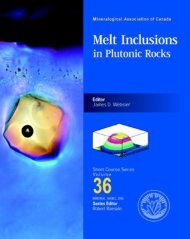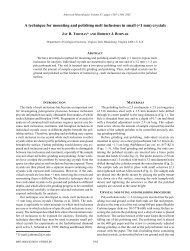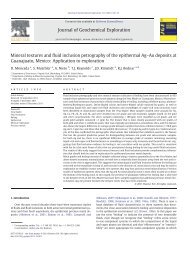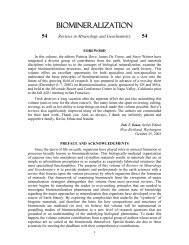Biomineralization Within Vesicles: The Calcite of Coccoliths
Biomineralization Within Vesicles: The Calcite of Coccoliths
Biomineralization Within Vesicles: The Calcite of Coccoliths
Create successful ePaper yourself
Turn your PDF publications into a flip-book with our unique Google optimized e-Paper software.
204 Young & HenriksenFigure 8. Growth pattern variations in Calcidiscus and Umbilicosphaera. <strong>Coccoliths</strong> <strong>of</strong> three closelyrelated species, in distal view. In each <strong>of</strong> these species the entire distal shield is formed <strong>of</strong> V-units, andthe visible surface are rhombic faces. (a) Calcidiscus leptoporus. (b) Umbilicosphaera sibogae. (c)well-formed Umbilicosphaera foliosa showing complex suture pattern and apparent division into twocycles <strong>of</strong> elements. (d) malformed U. foliosa showing a range <strong>of</strong> element morphologies from thosetypical <strong>of</strong> C. leptoporus to those typical <strong>of</strong> U. foliosa.<strong>The</strong> surfaces shown in Figures 8 and 9 are all characterized by growth across thesurface resulting in formation <strong>of</strong> inorganic rhombic crystal faces. <strong>The</strong>se are common,especially on distal surfaces and on central area structures (e.g., Rhabdosphaera, Fig. 7).Another class <strong>of</strong> surfaces also occurs, characterized by absence <strong>of</strong> growth on the surfaceand development <strong>of</strong> non-crystal surfaces (Henriksen et al. in press b; Young et al. in press).<strong>The</strong> distal shield <strong>of</strong> Coccolithus pelagicus shows examples <strong>of</strong> both surface types; growthoccurs incrementally on the upper surface, which develops as a rhombic face, while nogrowth occurs on the lower surface, which develops as a trailing surface behind the growthfront. Some coccoliths, e.g., Emiliania huxleyi, appear to be almost entirely characterizedby this surface type, with growth confined to narrow fronts at the tip <strong>of</strong> the element. Withthis type <strong>of</strong> growth it seems likely that crystal growth is blocked by organic coatings, mostlikely <strong>of</strong> coccolith-associated polysaccharides (Young et al. 1999). Such coatings arevisible on TEM sections after staining for polysaccharides (e.g., Outka and Williams 1971;Marsh 1994; Klaveness 1976; Young et al. 1999). We have been able to demonstratethrough AFM dissolution studies that these coatings do protect the completed crystals(Henriksen et al. in press b). It is reasonable to infer that a coating <strong>of</strong> polysaccharide thatcan prevent dissolution <strong>of</strong> an element would also serve to inhibit crystal growth. <strong>The</strong>refore,the difference between the two calcite surface types seen in coccoliths—rhombic calcite













